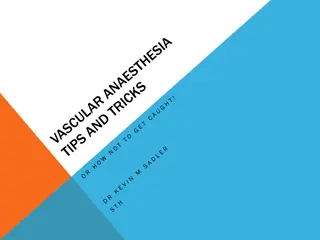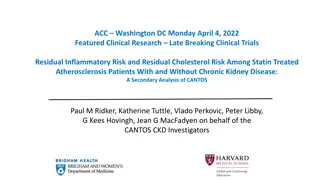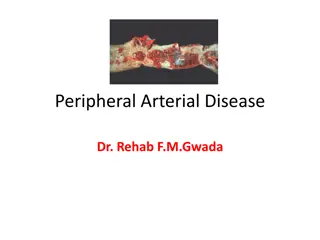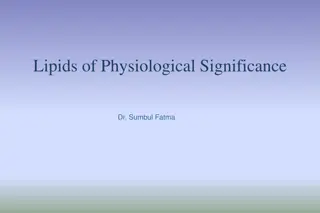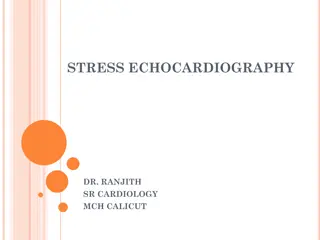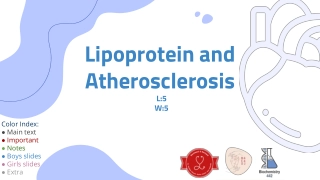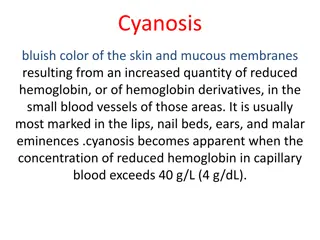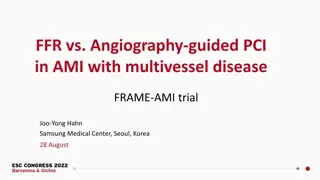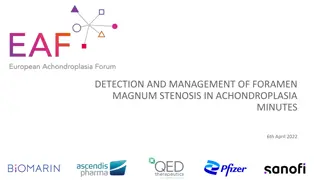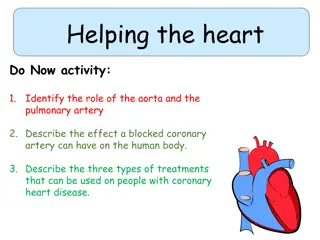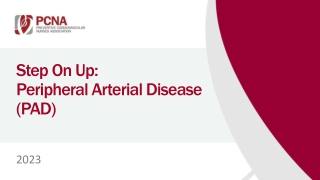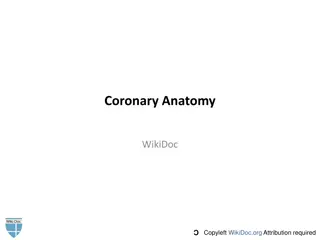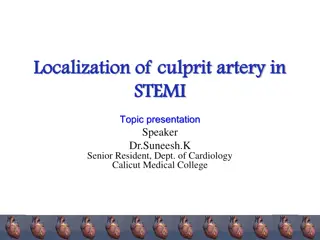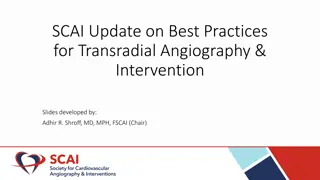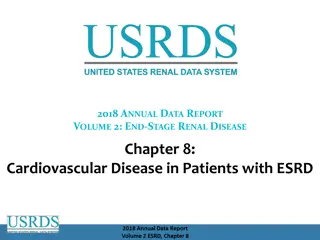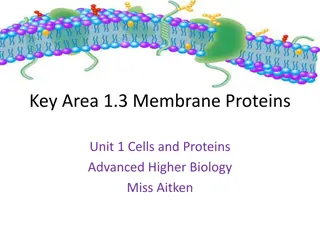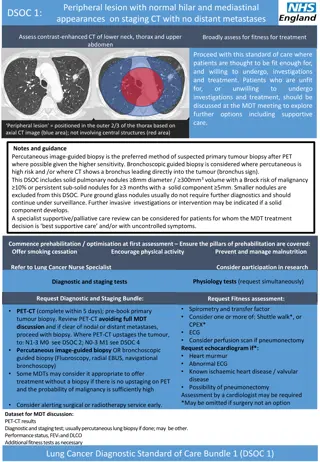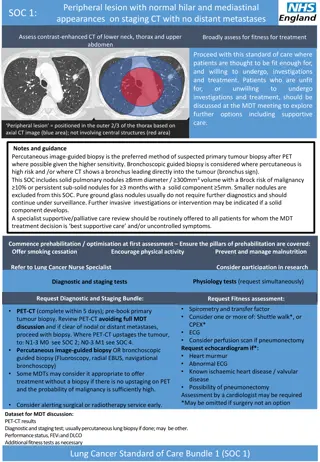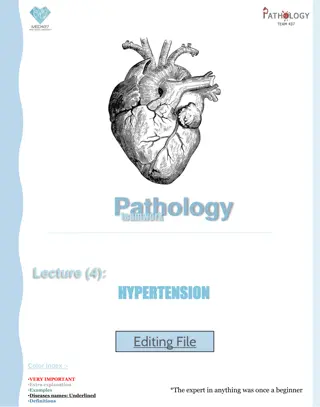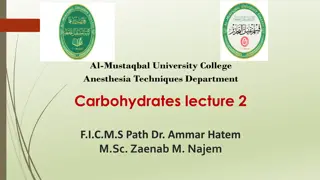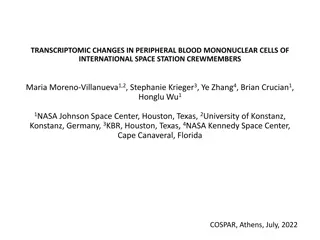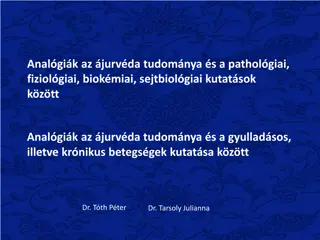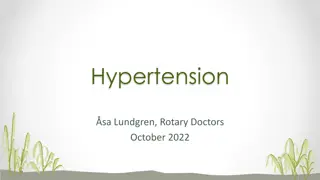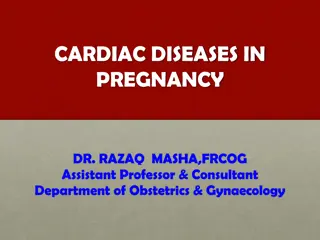Understanding Atherosclerosis, Peripheral Artery Disease, and Carotid Stenosis
This informative content details the histo-anatomy of blood vessels, pathophysiology of atherosclerosis, peripheral ischemia, and carotid artery disease. It covers the definition, risk factors, and processes involved in atherosclerosis, including endothelial cell function, blood flow dynamics, and factors contributing to endothelial injuries. Key topics such as acute limb ischemia, chronic ischemia symptoms, and the role of endothelial cells in regulating vessel constriction are discussed to provide a comprehensive understanding of vascular health.
Download Presentation

Please find below an Image/Link to download the presentation.
The content on the website is provided AS IS for your information and personal use only. It may not be sold, licensed, or shared on other websites without obtaining consent from the author. Download presentation by click this link. If you encounter any issues during the download, it is possible that the publisher has removed the file from their server.
E N D
Presentation Transcript
ATHEROSCLEROSIS PAD,CAROTID STENOSIS, ACUTE LIMB ISCHEMIA Dr.Elham Khoujah Consultant vascular/Endovascular surgeon.
ATHEROSCLEROSIS PAD,CAROTID STENOSIS, ACUTE LIMB ISCHEMIA OBJECTIVES: Review of histo-anatomy of a blood vessel. -layers of a blood vessel. Pathophysiology of atherosclerosis. -definition of atherosclerosis. -hemodynamic facts. -risk factors of atherosclerosis. -steps of atherosclerosis. Peripheral ischemia. -definition. -signs & symptoms of acute ischemia. -signs & symptoms of chronic ischemia. -anatomical land marks of peripheral pulses. Carotid artery disease. -anatomy. -risk factors. -history taking. -definition of TIA.
ATHEROSCLEROSIS PATHOPHYSIOLOGY Definition.. A process of progressive thickening and hardening of the walls of medium- sized and large arteries as a result of fat deposits on their inner lining. Heamodynamic facts.. The endothelial cells that line blood vessels provide an active, dynamic interface between the blood stream and the arterial wall. provide a semi-permeable barrier that regulates the exchange of fluid, nutrients, gases, and waste between the blood and tissues. provide unique surface that generally allows the cellular elements of blood to flow with adhering to the vessel lining .
ATHEROSCLEROSIS PATHOPHYSIOLOGY cont. Endothelial cells also regulate constriction and relaxation of vessels by releasing vasodilatory molecules (e.g., nitric oxide (NO) and prostacyclin (PGI2) and vasoconstrictive molecules (endothelin and angiotensin-II). When injury occurs, endothelial cells secrete cytokines that trigger and maintain an inflammatory response.
ATHEROSCLEROSIS PATHOPHYSIOLOGY cont. RISK FACTORS OF ENDOTHELIAL INJURIES.. Physical injury or stress as a result of direct trauma or hypertension . Turbulent blood flow, for example, where arteries branch. Circulation of reactive oxygen species (free radicals), e.g., from smoking or air pollutants. Hyperlipidemia (high blood concentrations of LDL or VLDL). Chronically elevated blood glucose levels. Homocysteinemia, which results from an inherited metabolic defect that leads to very high levels of the homocysteine, a metabolite of methionine; high concentrations are toxic to the endothelium.
ATHEROSCLEROSIS PATHOPHYSIOLOGY cont. Atherosclerosis is a disease process which is triggered by sometimes subtle physical or chemical insults to the endothelial cell layer of arteries.
(1) TOXIC INSULT (modified LPL,heamodynamic insults, infecious agents,oxidative stress) (3) INFLAMATORY RESPONS (adhesion to endothelium,migration to subendothelium, release of cytokines,platlet activation) (2) ENDOTHELIAL DYSFUNCTION (increase adherence,permeability,hypercoagulability, (8) THROMBUS FORMATION expression of adhesion molecules,release of chemokines) (rupture of fibrous cap or ulceration of plaque, continuing influx&activation of macrophages) (5) (4) FOAM CELL FORMATION (engulfing of LDL by macrophages) (layers of macrophages & (progression of intermediate lesion with FATTY STREAKS smooth muscle cells) fibrous cap formation,mixture of inflamatory (aggregation of lipid-rich macrophages & smooth muscle cells,intra. & extracellular & T-lymphocytes) lipid,increase matrix proteins & necrotic (6) INTERMEDIATE LESION (7) FIBROUS PLAQUE cellular debris)
PERIPHERAL ARTERIAL DISEASE It is the sequence of atherosclerosis of peripheral vessels excluding the carotids and coronaries.. PRESENTATION embolic thrombotic traumatic claudication critical limb ischemia acute chronic
PERIPHERAL ARTERIAL DISEASE Risk Factors.. Hypertension. Diabetes. Hyperlipidemia. Smoking. Familial tendency. Obesity. Gender.
PERIPHERAL ARTERIAL DISEASE HISTORY.. Pain.. Rule out other causes of pain of lower limb.. Patients with co-morbid conditions and can not walk, present late with rest pain or gangrene.. Drug/medical history.. Surgical history.. Family history: first degree relative with abdominal aortic aneurysm.. - location.. - precipating & aggrevating factors.. - frequency & duration..
PERIPHERAL ARTERIAL DISEASE Relationships between pain location and site of occlusion Buttock & hip----Aortoiliac disease.. *lerich syndrome triad ( claudication, absent femoral pulses, and erectile dysfunction) Thigh---Aortoiliac or common femoral artery.. Upper tow-thirds of the calf---Superficial femoral artery.. Lower one-third of the calf---Popliteal artery.. Foot claudication---Tibial arteries..
PERIPHERAL ARTERIAL DISEASE HISTORY.. Vascular review of symptoms.. - TIA.. - Difficulty in speech or swallowing.. - Dizziness / drop attacks.. - Blurred vision.. - Arm fatigue.. - Pain in abdomen after eating.. - Renal insuffisuncy (poorly controled DM+/- HTN) - Impotence.. - Cluadication/rest pain/tissue loss..
PERIPHERAL ARTERIAL DISEASE PHYSICAL EXAMINATION.. Inspection: - Change in color.. - Signs of ischemia.. - Burger's test.. - Capillary filling.. - Venous refilling.. - Pregangrenous /gangrenous part examination..
PERIPHERAL ARTERIAL DISEASE PHYSICAL EXAMINATION.. Palpation: - Skin temperature.. - Venous refilling.. - Peripheral pulses.. - Joint movements /muscle strength.. - Sensation.. Auscultation: - Bruits..
CAROTID ARTERY DISEASE Risk factors.. History.. Symptoms & signs..




